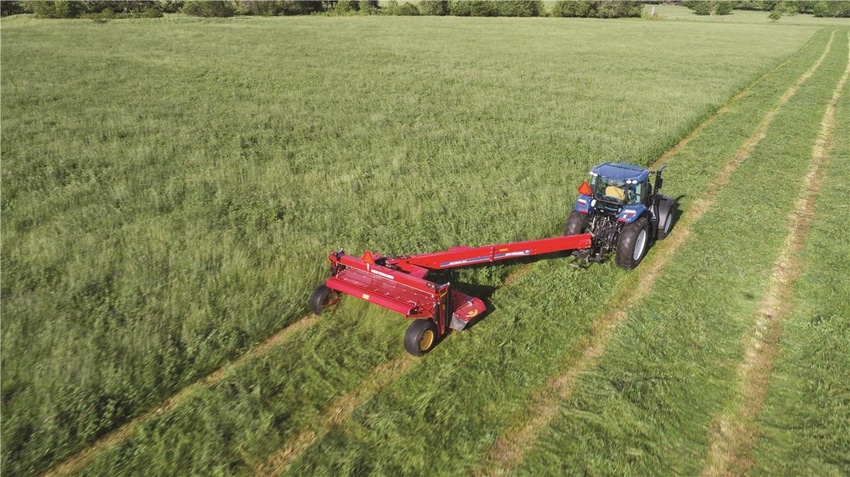
Laying down hay in the widest possible swath speeds drying, improves quality and probably saves money in the long run.
In fact, forming a wide swath at cutting is the single most important factor in maximizing initial drying rate and preserving starches and sugars, says Dan Undersander, University of Wisconsin extension agronomist.
Dairy producers and other high-end hay operations have been all over this knowledge in recent years, but it's likely most beef operations haven't latched onto this concept yet.
It may seem odd how haying ideas have changed over the years. New ideas about haying bring new designs in equipment, which then may affect ideas, which then may affect equipment design again. For example, in the early days of mechanized haymaking, sickle-bar mowers laid down hay in a full-width swath to dry before it was raked and stacked or baled. Then the mower-conditioner and cheap fuel changed the way people thought about haymaking and essentially encouraged more handling to speed drying, but in denser, narrower windrows. In the past 10-15 years researchers have shown that the widest possible swaths have the aforementioned advantages, and manufacturers have responded with new equipment and improved conditioning.
More information on these ideas typically can be found by searching for "hay swath width" and "hay-in-a-day."
Milewski added this looks to him like haymaking has come in a circle, but with some improvements. He says besides speed of drying and improved quality, this new knowledge should also mean less handling and hay loss prior to baling. He also believes it costs producers more to make poor quality hay, and several studies suggest the same. Among several reasons, higher-quality hay can reduce or eliminate the need for supplemental feeds, just by capturing more nutrients during haymaking.
For those putting up silage or haylage, this information can eliminate all but raking and either chopping and ensiling or baling; perhaps even eliminating conditioning. Those baling hay will still want to condition and may still find tedding worthwhile, some sources say.
Why it works
To understand the importance of drying, consider this statement by Undersander in a 2015 Hay & Forage Grower story: "When we cut alfalfa or a grass, it is generally 72-77% moisture. This means the crop must lose about 3 tons of water per acre (up to 720 gallons) to dry to haylage at 60-65% moisture. For dried hay, the impact is even greater. It must lose 5.7 tons of water per acre (1,370 gallons) to dry to 13% moisture when the yield is 2 tons per acre dry matter!"
How much difference does a wide swath make? In Wisconsin trials in 2007, when alfalfa was put into a wide swath it reached 65% moisture in about eight hours and could be harvested for haylage the same day as cutting. When put into a windrow it was not ready to be harvested until the next day, typically a difference of 10-12 hours.
This windrow issue has actually gotten worse as mowers have increased in size, say Undersander and Wisconsin extension worker Craig Saxe, because until very recently, conditioners stayed the same size inside the machines, resulting in narrower windrows.
However, most of the major equipment manufacturers are now making machines with wide-swath conditioners.
Capture more quality
Again citing that Wisconsin research from 2005-2007, putting alfalfa into wider swaths, at 72% of cut width immediately after cutting, resulted in improved quality of haylage compared with narrow windrows, at 25% of cut width. There was 11 points higher Relative Forage Quality for the wider-swathed haylage when it was tested two months after storing. There was also higher crude protein, higher non-fiber carbohydrate (energy), lower neutral detergent fiber, and higher lactic acid, which would reduce spoilage at feeding time.
These days, many new mower-conditioners are well above 80% swath-to-cut ratios, but alfalfa can be cut with a narrower machine and spread with a tedder, Undersander says. Grass hay does not work well with such treatment, however, because it tends to settle into the stubble.
Speaking of stubble, most publications and hay researchers suggest cutting a slightly higher stubble to support the wide windrows off the ground. This allows more air circulation under the cut forage and also reduces the amount of soil, and therefore ash, that ends up in the hay. Still, most research tends to show less ash in wide-swathed hay, perhaps because narrow windrows are heavier and tend to sink into ground contact.
Be aware that faster drying will change your work timetable. Rake at 40-60% moisture with alfalfa and 25% for grasses. These percentages can be reached in or less, much more quickly than if you are accustomed to narrower windrows.
Know 3 steps of hay curing
If you understand the three steps of hay drying and curing, it's easier to grasp why wide swaths make such a difference.
Stage 1: Leaves dry.
The first phase of moisture loss is through open stomata, which are the pores through which plants exchange moisture and gases with the atmosphere. Stomata open in sunlight and close in the dark, even after cutting, so laying down a wide swath exposes more of the stomata to sunlight so they remain open. Research shows wide swathing speeds the drying of this initial 15% of moisture and can preserve more of the starches and sugars for higher quality forage, in addition to the fact the plant is still photosynthesizing.
Stage 2: Surface dries.
The second phase of drying is moisture loss from the plant surfaces, including leaves and stems. At this point the stomata have closed. Mechanical conditioning moisture to escape by breaking the waxy cuticle and this lets moisture escape more quickly, speeding this stage of drying. Wide swaths can help here, too.
Stage 3: Stems dry.
The final and most critical drying stage is the loss of tightly held moisture trapped inside the stems. To increase drying of this material, mechanical conditioning is essential. Again, wide swaths increase surface area.
About the Author(s)
You May Also Like




